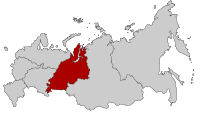Ural Federal District
| Уральский федеральный округ (Russian) Urals Federal District |
|
|---|---|
 Location of the Urals Federal District (within Russia) |
|
| Anthem: None | |
| Administrative center | Yekaterinburg |
| Established | May 18, 2000 |
| Political status Federal subjects Economic regions |
Federal district 6 contained 2 contained |
| Area | |
| Area - Rank within Russia |
1,788,900 km² 3rd |
| Population (as of the 2002 Census) | |
| Population - Rank within Russia - Density - Urban - Rural |
12,373,926 inhabitants 6th 6.9 inhab. / km² n/a n/a |
| Official language | Russian others |
| Government | |
| Presidential Envoy | Nikolay Vinnichenko |
| Official website | |
| http://www.uralfo.ru/ | |
Ural Federal District (Russian: Ура́льский федера́льный о́круг, Uralsky federalny okrug) is one of the eight federal districts of Russia. The district was established on 13 May 2000 by a decree of the President of Russia.[1] The district is mostly located in the geographical region of Ural, but also includes some parts of the Volga Region; its extent is different from that of the Ural economic region. The administrative center of the district is Yekaterinburg.
General information and statistics
The district covers an area of 1,788,900 square kilometers (690,698.2 sq mi), that is about 10% of Russia, and according to the 2002 Census had a population of 12,373,926 that is 8.52% of Russian population. Of those, 82.74% were Russians (10,237,992 people), 5.14% Tatars (636,454), 2.87% Ukrainians (355,087) and 2.15% Bashkirs (265,586). The remainder is comprised by various nationalities of the former Soviet Union. Urban population constituted 79.6%. It was mostly concentrated in Yekaterinburg (1,293,537), Chelyabinsk (1,077,174), Tyumen (510,719), Magnitogorsk (418,545), Nizhny Tagil (390,498), Kurgan (345,515) and Surgut (285,027).[2]
In 2006, the district was providing 90% of the Russian production of natural gas, 68% of oil and 42% of the metal products. Industrial production per capita in the district is about 2.5 higher than the average value in Russia. The district provides about 42% of the Russian tax incomes, and most of these 42% are due to the industry. Its major branches are fuel mining and production (53%), metallurgy (24%) and metal processing and engineering (8.8%). Metal processing and engineering are especially developed in Chelyabinsk and Sverdlovsk Oblast where their fractions are about 83% and 73%, respectively. Whereas fuel and mineral mining has been providing a nearly constant outcome between 1990 and 2006, metal processing and engineering are declining, despite they employ up to 30% of industry workers of the district. The production of metal-cutting machines, excavators, tractors, bulldozers, buses and steel-making equipment decreased 6–34 times, and manufacturing of household appliances and agricultural equipment almost halted. The fraction of machinery in total industrial products decreased from 20% in 1990 to 2.5% in 2006. The machinery required for other Ural's industries is mostly imported, at a volume of $1.7 billion per year. More than a third of machinery plants are unprofitable. Among the causes of the decline are lack of local resources and increasing transport prices. Local ore processing plants can provide only 20% of required copper, 28% chromium, 35% iron and 17% coal, and many of these resources are nearly exhausted. Meanwhile, the average distance to import them to Ural is 2,500 km.[3]
The district is governed by the Presidential Envoy, and individual envoys are assigned by the President of Russia to all the Oblasts of the district. Pyotr Latyshev had been the envoy to the Urals Federal District until his death on December 2, 2008. Nikolay Vinnichenko succeeded him on this post on December 8, 2008.[4]
.svg.png) |
|||
|---|---|---|---|
| # | Flag | Federal subject | Administrative center |
| 1 | Kurgan Oblast | Kurgan | |
| 2 | Sverdlovsk Oblast | Yekaterinburg | |
| 3 | Tyumen Oblast | Tyumen | |
| 4 | Khanty-Mansi Autonomous Okrug |
Khanty-Mansiysk | |
| 5 | Chelyabinsk Oblast | Chelyabinsk | |
| 6 | Yamalo-Nenets Autonomous Okrug |
Salekhard | |
References
- ↑ "Указ Президента РФ от 13 мая 2000 г. N 849 "О полномочном представителе Президента Российской Федерации в федеральном округе" (Decree No 849 by the President of Russia on 13 May 2000)" (in Russian). http://base.garant.ru/12119586/.
- ↑ Федеральная служба государственной статистики (Federal State Statistics Service) (2004-05-21). "Численность населения России, субъектов Российской Федерации в составе федеральных округов, районов, городских поселений, сельских населённых пунктов – районных центров и сельских населённых пунктов с населением 3 тысячи и более человек (Population of Russia, its federal districts, federal subjects, districts, urban localities, rural localities—administrative centers, and rural localities with population of over 3,000)" (in Russian). Всероссийская перепись населения 2002 года (All-Russia Population Census of 2002). Federal State Statistics Service. http://www.perepis2002.ru/ct/doc/1_TOM_01_04.xls. Retrieved 2008-07-25.
- ↑ "Екатеринбург, 02 Декабря 2006" (in Russian). Official site of the Ural Federal District. http://www.uralfo.ru/?read=1272.
- ↑ "Vinnichenko for Urals Federal District" (in Russian). interfax.ru. http://interfax.ru/politics/txt.asp?id=50263.